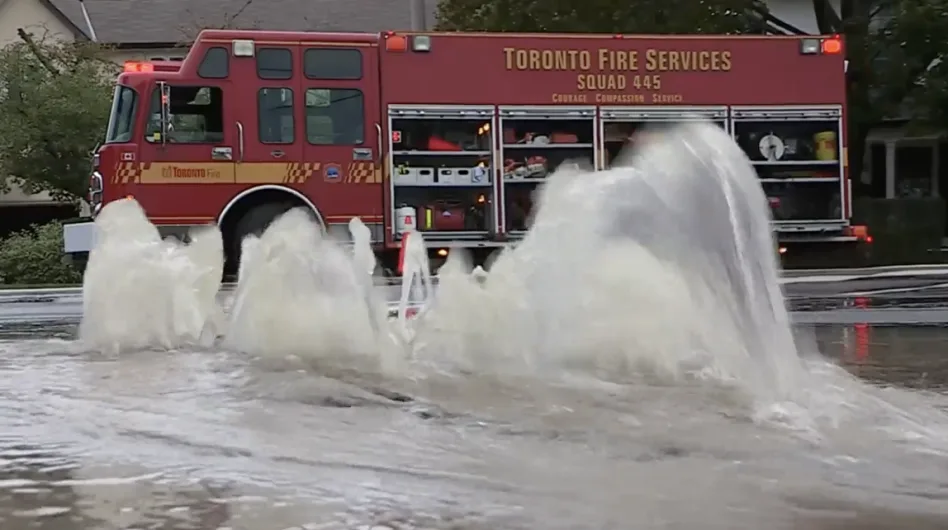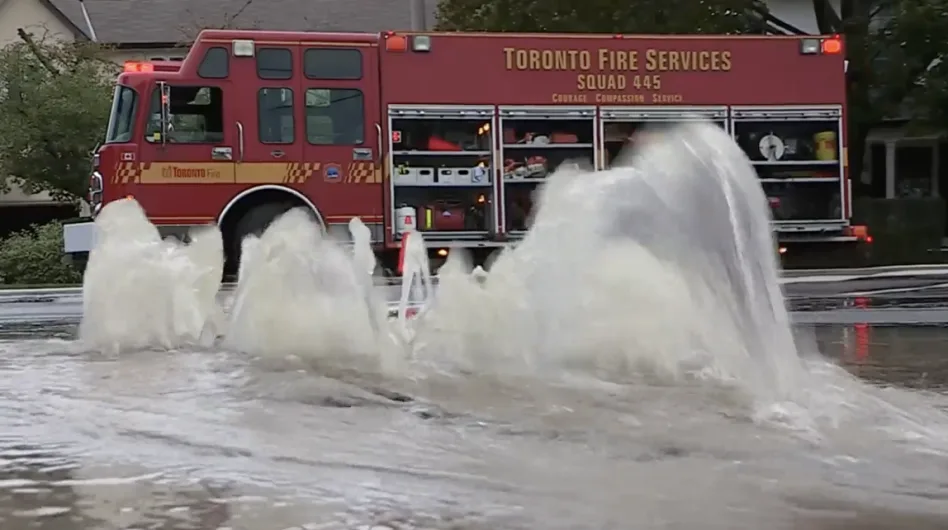
Did a water main break near your home? Here's what happens next
Temperature swings can be problematic for infrastructure, especially one area in particular — water mains. The Weather Network's Mark Robinson talks to Toronto water official William Shay to discuss how the city fixes these breaks.
You flick the tap on, expecting clean, clear water to brush your teeth to come gushing out and instead, all you get is a vague burping noise. You slap the tap a couple of times because that always seems to help. Only, this time, percussive maintenance doesn’t work.
What’s going on?
What you’re not seeing is that all that wonderful water geysering out of the street a few blocks away because that cold snap that The Weather Network warned you about shifted the ground just enough to break a water main. And now your teeth are going to remain fuzzy for at least a little while.
Clean water that’s available at all times is a critical part of modern urban life, but that water availability comes with a cost that isn’t always apparent. In a city like Toronto, water moves from Lake Ontario to your home through a network of pipes that, if laid end-to-end, would stretch from Halifax to Vancouver. That’s a lot of piping to maintain and repair, especially when a lot of that infrastructure was created before modern materials like PVC were available.
I wanted to know when and how water main breaks happen (and what happens when they do), so I went to talk to the person in charge of Toronto’s water; Bill Shea, Director of Distribution and Collection for Toronto Water. I met him amidst an outdoor display of massive water pipes, taps and shutoff valves the size of small cars, and a small assortment of old, broken water mains. He had come prepared to show off what is a hidden, but critical (and massive), part of our city’s infrastructure.
“We’ll do a billion litres in a day for Toronto,” Bill tells me, “We’re serving 3 million people so that’s a lot of water.”

On average, a repair can take up to 8 hours from start to finish. (Photo credit: Mark Robinson/The Weather Network)
And keep in mind, that’s just the centre area of the GTA. When you add in Peel and Halton regions as well as the smaller regions, the amount of water that moves through the urban area is just mind boggling.
However, as with any complex system, things can and do go wrong.
“Generally, it’s the older water mains that break, the cast iron ones," says Bill. "This can happen because of acidic soils that cause the pipes to rust and eventually a hole can appear. But, in the winter, the ground freezes and when it does, the ground shifts and moves the cast iron pipes. The cast iron pipes are thick, but quite brittle and the shift cracks them.”
“The worst years happen when the temperature goes up and down. When it transitions into cold, we’ll start seeing breaks, but when the temperature suddenly goes up, you get a lot more because of the fast shifts in the ground.”
Once the leak is found (often because there’s water geysering out of the ground), Bill’s teams launch into gear.
“It’s a complex process,” he explains. “The City has a lot of traffic, people want to keep going, they don’t like when we shut the road down. There’s also a lot of utilities down there like power and internet cables, but our people are very good at getting it done well and getting it done quickly.”
“The first thing we do is find out where the break is and shut off the water because flooding can cause all kinds of damage in the city. Then, we start digging and once we get to the break there are various means of repairing it. If it’s a hole, we can just use a stainless-steel clamp to maintain the water pressure and those can last 50 years. If it’s really bad, a long crack, we actually have to take out the water main and replace it with a piece of plastic. On average, it takes about eight hours from start to finish.”
WATCH BELOW: INDOOR WINTER ALLERGY CULPRITS
The speed at which the repair can happen really amazed me, but Bill explained that even if the crews take a short time to get a break fixed, they’re always dealing with a high volume of breaks.
“In 2021, we had about 700 breaks, and we have to be quick and efficient or we get a lot of complaints.”
The City of Toronto does have plans to deal with breaks in the long term by both replacing old lines and lining some with modern, rugged materials, but in the short term, Bill cautions residents that breaks are, unfortunately, a part of life in the city.
“When you have anywhere near the age of infrastructure that Toronto has, it doesn’t matter how fast we do these upgrades or how fast we do the rehabilitations — we have 5000 kilometres of water mains so we’re going to have breaks and all we ask is for patience. We try to get things repaired as fast as possible, but it does cause disruption and we don’t like it any more than you do.”
So, just hold off on brushing your teeth for a bit but, rest assured that while the weather is working away to ensure your teeth are fuzzy, the intrepid repair crews are working away to ensure that they don’t stay fuzzy for long.
Check out the video that leads this article for a bit more detail about the repair process and to get an idea of the scale you may be dealing with.











